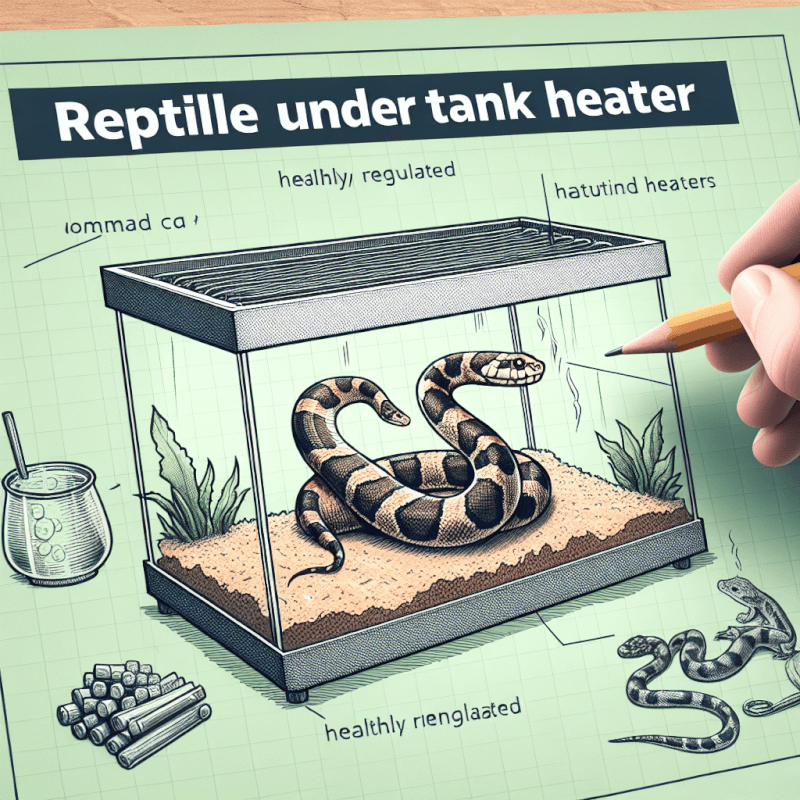Imagine having the perfect heating solution for your reptile companion without sacrificing the aesthetics of their tank. Introducing the Reptile Under Tank Heater – a revolutionary product that discreetly provides the ideal temperature for your scaly friend, all while preserving the beauty and integrity of their habitat. With its innovative design and unparalleled functionality, this reptile under tank heater is the ultimate must-have accessory for reptile lovers everywhere. Say goodbye to unsightly heating elements and welcome a cozy and inviting environment for your reptile, right at the bottom of their tank. Give your reptile the warmth they deserve and create a haven they’ll love to call home with the Reptile Under Tank Heater.
What is a Reptile Under Tank Heater?
A reptile under tank heater is a heating device specifically designed to provide warmth to the habitat of reptiles, such as snakes, lizards, and turtles. It is placed beneath the enclosure, creating a warm surface for the reptile to rest on. The heat generated by the under tank heater helps to regulate the temperature of the habitat, mimicking the natural conditions that reptiles require to thrive.
Advantages of Using a Reptile Under Tank Heater
1. Regulates temperature efficiently
One of the primary advantages of using a reptile under tank heater is its ability to regulate the temperature of the enclosure efficiently. Reptiles are ectothermic animals, meaning they rely on external sources of heat to maintain their body temperature. The under tank heater provides a consistent and comfortable heat source, ensuring that the reptile’s habitat remains at the desired temperature range.
2. Ideal for creating heat gradient
A heat gradient is crucial for reptiles as it allows them to thermoregulate by moving to cooler or warmer areas of their enclosure as needed. The under tank heater is particularly effective in creating a heat gradient, as it primarily heats the floor of the habitat. This setup enables the reptile to choose the ideal temperature zone for their needs, promoting natural behavior and overall well-being.
3. Provides a natural heating source
In the wild, reptiles bask in the warmth of the sun or absorb heat from natural surfaces such as rocks. A reptile under tank heater emulates this natural heating source, allowing reptiles to experience a familiar and comfortable environment. This not only supports their physiological and behavioral needs but also helps to reduce stress levels.
4. Safe and easy to use
Reptile under tank heaters are designed with safety in mind. Most models come with built-in features such as temperature control and automatic shut-off mechanisms to prevent overheating. These heaters are also straightforward to install, and their low-profile design ensures they do not interfere with the aesthetics of the enclosure.

5. Cost-effective
Compared to other heating options available for reptiles, under tank heaters are often more cost-effective. They consume less energy and provide efficient heat distribution, making them an economical choice for reptile owners. Additionally, the long lifespan of under tank heaters further contributes to their cost-effectiveness, as they require minimal maintenance and replacement.
Types of Reptile Under Tank Heaters
Several types of reptile under tank heaters are available on the market, each with its unique features and benefits. Understanding the different types can help you choose the most suitable option for your reptile’s needs.
1. Heat Pads
Heat pads, also known as heat mats or substrate heaters, are adhesive heating pads that are placed underneath the aquarium or terrarium. They provide a uniform heat to the entire floor area, ensuring an even distribution of warmth. Heat pads are popular for their ease of use and versatility, as they can be used with various tank sizes and reptile species.
2. Heat Tapes
Heat tapes, also called heat cable, are flexible strips that generate heat when connected to a power source. They can be secured to the bottom or sides of the enclosure, providing heat in specific areas. Heat tapes are highly customizable and are often used for larger habitats or reptiles with specific temperature requirements.
3. Heat Rocks
Heat rocks, also known as hot rocks or basking stones, are flat rocks that contain a heating element inside. They are placed in the enclosure and provide a localized heat source for reptiles to bask on. Heat rocks are ideal for reptiles that require a direct heat source, such as certain lizard species. However, it is essential to choose a heat rock with a reliable temperature control mechanism to prevent burns or overheating.
Choosing the Right Reptile Under Tank Heater
When selecting a reptile under tank heater, several key factors should be considered to ensure it meets the specific needs of your reptile and their enclosure.

1. Size and Wattage
The size and wattage of the under tank heater should be suitable for the dimensions of your reptile’s habitat. Ensure that the heater’s dimensions match the dimensions of the tank, and choose a wattage that is appropriate for the required temperature range. It is crucial to follow the manufacturer’s recommendations to prevent under or over-heating.
2. Temperature Control
Opt for an under tank heater with temperature control features, such as a built-in thermostat or rheostat. This allows you to set and maintain the desired temperature accurately. Temperature control is particularly vital if you have reptiles that have strict temperature requirements or if the ambient temperature in your home fluctuates.
3. Safety Features
Prioritize safety features when selecting a reptile under tank heater. Look for models with automatic shut-off functions that engage if the temperature exceeds a safe threshold. Additionally, consider heaters with protective housing or guards to prevent direct contact between the reptile and the heating element, reducing the risk of burns.
4. Compatibility with Tank Type
Different reptiles may require different types of enclosures, such as glass aquariums or wooden terrariums. Ensure that the under tank heater you choose is compatible with the type of tank you have, as some heaters are specifically designed for a particular material or have special installation instructions.
Installation and Placement
Proper installation and placement of the reptile under tank heater are crucial to ensure its effectiveness and safety.

1. Preparing the Tank
Before installing the heater, thoroughly clean the tank to remove any dust or debris that could interfere with the heater’s adhesive or performance. Ensure the tank is dry, as a moist or wet surface can reduce the effectiveness of the heater and lead to malfunctions.
2. Proper Placement
The under tank heater should be placed on the outside of the tank, directly beneath the floor of the enclosure. It is essential to position the heater on one side of the tank rather than the center, creating a heat gradient within the habitat. This allows the reptile to choose their preferred temperature zone.
3. Securing the Heater
Follow the manufacturer’s instructions to secure the under tank heater to the bottom of the tank. Most heaters come with adhesive backing or suction cups that allow for easy and secure attachment. Ensure that the heater is firmly attached to prevent it from shifting or detaching, which could pose a hazard to the reptile and affect the heater’s performance.
Temperature Regulation and Monitoring
Maintaining the correct temperature in your reptile’s enclosure is vital for their health and well-being. Proper temperature regulation and monitoring are essential when using a reptile under tank heater.
1. Using a Thermostat
A thermostat is a crucial accessory when using a reptile under tank heater. It helps regulate the temperature by turning the heater on or off as needed to maintain the desired temperature range. Connect the under tank heater to the thermostat and set it to the appropriate temperature for your reptile species. Regularly check and adjust the thermostat settings to ensure accuracy.

2. Temperature Measurement Tools
To monitor the temperature accurately, use a reliable temperature measuring tool, such as a digital thermometer or an infrared temperature gun. Place the probe or sensor at the desired height within the enclosure to gauge the temperature gradient across different areas. Regularly check the temperature throughout the day and make necessary adjustments to the heater or thermostat settings if needed.
Maintenance and Safety Precautions
To ensure the continued effectiveness and safety of your reptile under tank heater, proper maintenance and adherence to safety precautions are essential.
1. Cleaning the Heater
Regularly inspect and clean the under tank heater to remove any dust, debris, or reptile waste that may accumulate on its surface. Use a soft cloth or a gentle brush to wipe away any buildup without damaging the heating element. Ensure the heater is completely dry before reattaching it to the tank.
2. Regular Inspection
Periodically inspect the under tank heater for any signs of damage or wear. Check the power cord, connectors, and adhesive backing for any fraying, cracks, or other signs of deterioration. If you notice any damage, discontinue using the heater and replace it promptly to prevent safety hazards.
3. Safety Tips
Always prioritize the safety of your reptile. Avoid placing any objects directly on top of the under tank heater, as this can obstruct the heat distribution and potentially cause overheating. Additionally, provide a thermal gradient within the enclosure by offering cooler zones away from the heater, allowing your reptile to regulate their body temperature effectively.
Common Issues and Troubleshooting
Despite proper maintenance and care, some common issues may arise when using a reptile under tank heater. Here are a few troubleshooting tips for dealing with these problems:
1. Inadequate Heating
If the under tank heater fails to reach the desired temperature or maintain a consistent heat, check that it is securely attached to the tank and free from any obstructions. Ensure that the wattage and size of the heater are appropriate for the enclosure. If the issue persists, consider replacing the heater or contacting the manufacturer for further assistance.
2. Uneven Temperature Distribution
If you notice significant temperature variations within the habitat, check the positioning of the under tank heater. It may be necessary to readjust placement to create a more balanced temperature gradient. Adding additional heat sources, such as ceramic heat emitters or heat lamps, can also help distribute heat more evenly.
3. Overheating
If the enclosure becomes too hot or if the temperature exceeds the safe range, check the accuracy of the thermostat settings. Ensure that the thermostat is functioning correctly and properly calibrated. If necessary, replace the thermostat or consult a reptile heating specialist for guidance.
4. Electrical Problems
In the event of an electrical malfunction, such as a power outage or an issue with the heater’s electrical components, ensure the under tank heater is turned off and disconnected from the power source. Contact a qualified electrician or the heater manufacturer for assistance with resolving electrical issues.
Other Heating Options for Reptiles
While reptile under tank heaters are a popular and effective heating option, other alternatives can also be considered depending on your reptile’s specific needs.
1. Ceramic Heat Emitters
Ceramic heat emitters emit infrared heat and can be used as a primary heat source or in conjunction with an under tank heater. They do not emit light, making them suitable for nocturnal reptiles or enclosures where light disruption is undesirable.
2. Heat Lamps
Heat lamps, often equipped with infrared or halogen bulbs, provide both heat and light to reptile habitats. They can be used to create a basking spot or supplement the heat provided by an under tank heater. Ensure that the heat lamp is positioned at a safe distance from the reptile to prevent burns.
3. Radiant Heat Panels
Radiant heat panels are wall or ceiling-mounted heating devices that emit gentle, long-wave infrared heat. These panels are highly efficient and distribute heat evenly throughout the enclosure. They are particularly suitable for larger habitats or reptiles that require a consistent temperature gradient.
Conclusion
A reptile under tank heater is an excellent investment for reptile owners, providing a reliable and natural heat source for their cold-blooded companions. By efficiently regulating temperature, creating heat gradients, and offering a safe and cost-effective heating option, under tank heaters enhance the overall well-being and comfort of reptiles living in captivity. Whether you choose heat pads, heat tapes, or heat rocks, proper installation, temperature regulation, and regular maintenance will ensure the optimal functioning of the under tank heater and a thriving environment for your reptile.


